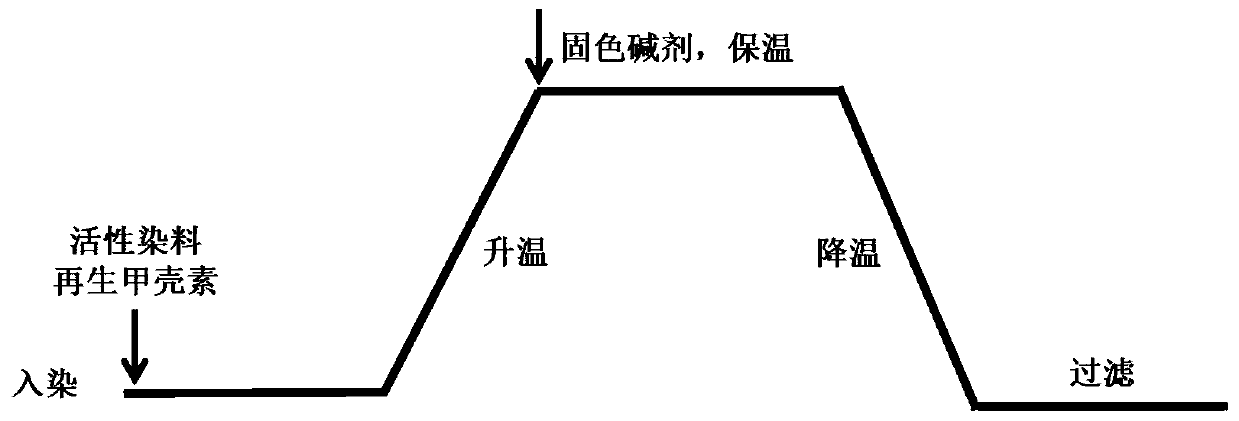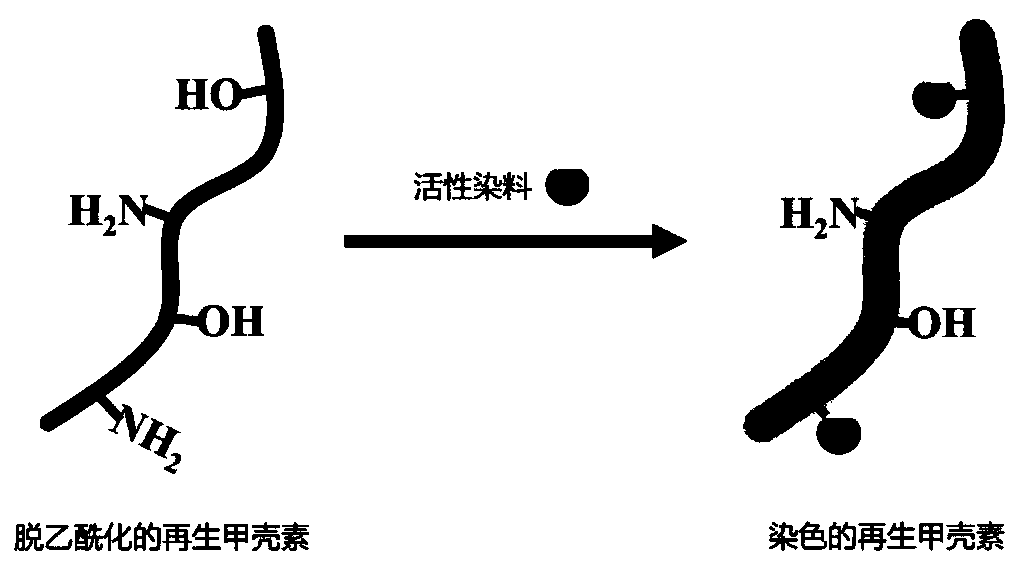Preparation method of regenerated chitin color pastes
A chitin and plain color technology, applied in the field of preparation of regenerated chitin color paste, can solve problems such as few reports, and achieve the effects of excellent emulsifying ability, good viscoelastic performance and easy production
- Summary
- Abstract
- Description
- Claims
- Application Information
AI Technical Summary
Problems solved by technology
Method used
Image
Examples
Embodiment 1
[0032] (1) Add chitin (derived from shrimp shells) to 35% sodium hydroxide solution and react at 60°C for 1 hour to obtain partially deacetylated chitin, and then use phosphoric acid to dissolve and regenerate partially deacetylated chitin to obtain The deacetylated regenerated chitin suspension, the deacetylation degree of the regenerated chitin is 8% after testing.
[0033] (2) the regenerated chitin suspension of step (1) and reactive red 194 dyes are mixed and stirred to obtain red initial dye liquor, wherein the concentration of regenerated chitin in the initial dye liquor is 5g / L and reactive red 194 dyestuffs The concentration in the initial dyeing solution was 2g / L, and then dyed at 25°C for 30min.
[0034] (3) The dyeing solution in step (2) is raised from 25°C to 70°C at a temperature increase rate of 2°C / min, then add color-fixing alkali agent sodium carbonate (30g / L), and fix the color at 70°C for 60min, then The temperature was lowered to room temperature, and th...
Embodiment 2
[0038] (1) Add chitin (derived from shrimp shells) to 35% sodium hydroxide solution and react at 60°C for 5 hours to obtain partially deacetylated chitin, and then use phosphoric acid to dissolve and regenerate partially deacetylated chitin to obtain The deacetylated regenerated chitin suspension, the deacetylation degree of the regenerated chitin is 25% after testing.
[0039] (2) the regenerated chitin suspension of step (1) and reactive red 194 dyes are mixed and stirred to obtain red initial dye liquor, wherein the concentration of regenerated chitin in the initial dye liquor is 10g / L and reactive red 194 dyestuffs The concentration in the initial dye solution was 5g / L, and then dyed at 30°C for 20min.
[0040] (3) Raise the dye solution in step (2) from 30°C to 65°C at a heating rate of 1.5°C / min, then add the color-fixing alkali agent sodium bicarbonate (20g / L), and fix the color at 65°C for 45min, Then the temperature was lowered to room temperature, and the crude prod...
Embodiment 3
[0044] (1) Add chitin (derived from shrimp shells) to 35% sodium hydroxide solution and react at 90°C for 5 hours to obtain partially deacetylated chitin, and then use phosphoric acid to dissolve and regenerate partially deacetylated chitin to obtain The deacetylated regenerated chitin suspension has a deacetylation degree of 39% after testing.
[0045] (2) the regenerated chitin suspension of step (1) and reactive red 194 dyes are mixed and stirred to obtain red initial dye liquor, wherein the concentration of regenerated chitin in the initial dye liquor is 15g / L and reactive red 194 dyestuffs The concentration in the initial dye solution was 10g / L, and then dyed at 25°C for 15min.
[0046] (3) The dyeing solution in step (2) is raised from 25°C to 75°C at a rate of 2°C / min, and then the color-fixing alkali agent sodium carbonate (25g / L) is added, and the color is fixed for 90min at 75°C, and then The temperature was lowered to room temperature, and the crude product of red ...
PUM
 Login to View More
Login to View More Abstract
Description
Claims
Application Information
 Login to View More
Login to View More - R&D
- Intellectual Property
- Life Sciences
- Materials
- Tech Scout
- Unparalleled Data Quality
- Higher Quality Content
- 60% Fewer Hallucinations
Browse by: Latest US Patents, China's latest patents, Technical Efficacy Thesaurus, Application Domain, Technology Topic, Popular Technical Reports.
© 2025 PatSnap. All rights reserved.Legal|Privacy policy|Modern Slavery Act Transparency Statement|Sitemap|About US| Contact US: help@patsnap.com



